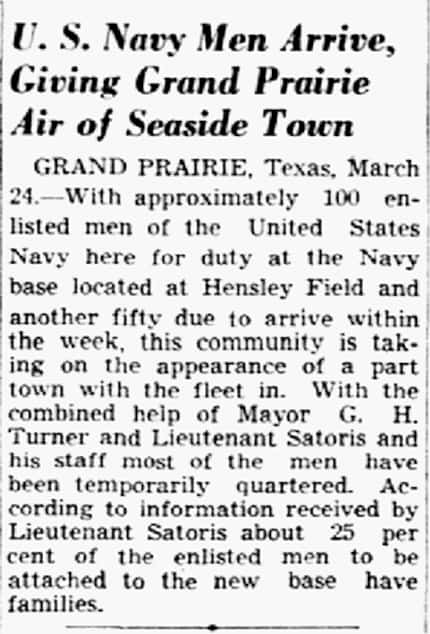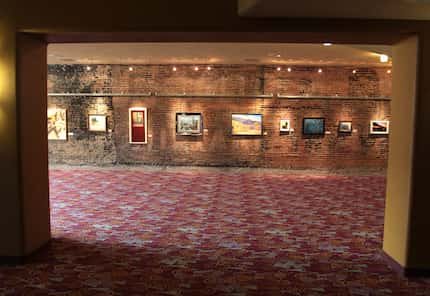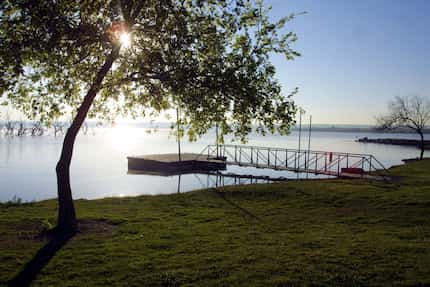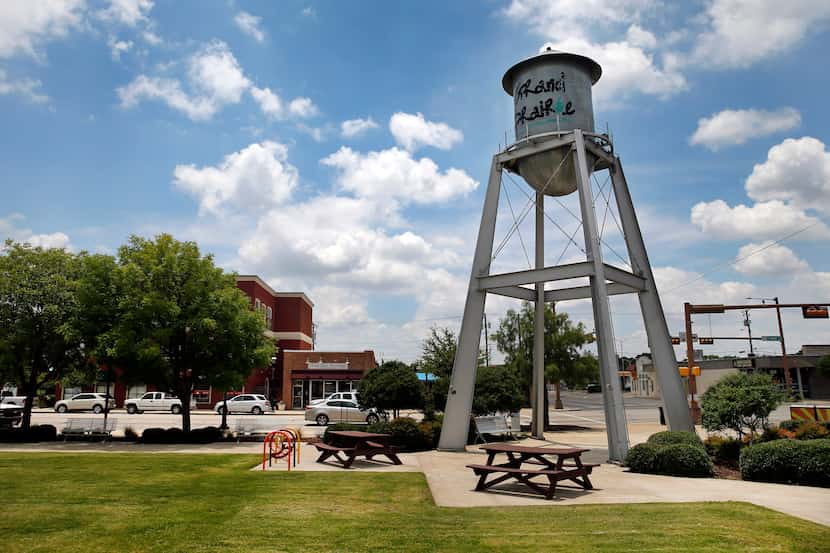Editor’s note: Take a look back into The Dallas Morning News Archives and our specially curated City of Grand Prairie historical collection.
Sitting midway between downtown Dallas and downtown Fort Worth, and part of three different counties, Grand Prairie is a unique suburb that has developed its own identity over the decades. Moving beyond the basic farming and railroad roots that most North Texas communities have, Grand Prairie also has a history in the aviation and entertainment industries.
The beginnings
The city of Grand Prairie was founded as Dechman, after the original founder, Alexander Dechman, who paid $200 in Confederate money for the land in 1863. The land he originally bought lies within what is now downtown Grand Prairie. Before he could settle in the town himself, Dechman joined with the Confederate Army during the Civil War.
After filing the title for the land with the county, Dechman granted right-of-way to the railroad and later filed a plat that gave the Texas and Pacific Railroad every other lot in exchange for operating a depot. Service began on the railroad in 1876 and the next year the town was renamed Grand Prairie by the railroad because of the town’s location on, “the eastern edge of the vast grand prairie that stretched into West Texas.”

By the time the town voted for incorporation in 1909, the Grand Prairie Independent School District had been established, and the downtown district was thriving, with a drugstore, cotton gin, grocery stores, a hotel, post office and more. The News reported that the town had nearly doubled in population over the past 18 months and that Grand Prairie was, “rapidly developing into a factory and suburban home center.”
Grand Prairie was victim to several damaging fires in its early years and an organized fire department opened in 1917. The first water system was installed in 1918.
From cotton to airplanes
Throughout the 1920s and 1930s, the city continued growing, largely attracting cotton farmers; in an article published Sept. 4, 1921, The News referred to Grand Prairie as a “Big Cotton Town,” with commentary that “Schools Are Worthy.”
In the late 1920s, Grand Prairie began a progression into the aviation industry, with the announcement that pilots from Fort Worth and Dallas would train at the town’s new airdrome. According to The News, the new airfield got the highest rating of any airport in the United States after inspection by Colonel Hensley.

While the town was growing and thriving with new industry, those of a more nefarious sort were attracted to town also. In 1934, The News reported that the gang that robbed the Grand Prairie State Bank of $1,543.74 on March 19, was the infamous Clyde Barrow-Raymond Hamilton gang, with the driver of the escape car identified as Hamilton himself. This came after a previous robbery of the Interurban ticket office in downtown Grand Prairie in 1931 by Hamilton and Barrow.
Grand Prairie and World War II

Grand Prairie’s foray into the aviation industry hit new heights with the onset of World War II and brought even more growth to the town. The News reported in 1940 that “Expansion is due from influx airplane plant to bring.” The arrival of the North American Aviation, Inc. factory was highly anticipated. In August of 1940, the site of the future $7 million warplane factory brought hundreds of visitors to Grand Prairie. According to the Grand Prairie website, North American Aviation was the first “windowless, fully [air-conditioned] and artificially lit aircraft production facility in the nation.” Also, popular with these visitors was the Lou Foote Airport and Hensley Field, from then on known as the Naval Reserve Aviation Base, where numerous army planes were in plain view.
In March of 1941, The News reported there were approximately 100 enlisted men of the United States Navy on duty at Hensley field, with more on their way. In that decade alone, the town grew from a population of 1,000 to 15,000. The population increase led to the construction of Avion Village in Grand Prairie in the early 1940s. Only people who were directly employed in defense work were eligible for residence.
Post-war growth
Even once World War II ended, Grand Prairie still enjoyed booming growth. A Dallas Morning News article published in 1962 stated, “The one time interurban stop that exploded during World War II into Big D’s largest suburban industrial center is now set up to spread people and plants over some 57 square miles of area.” Many institutions founded during this period still live on today and there were improvements made that benefited the town and supported further growth.

The historic Uptown Theater opened in March of 1950 as an unsegregated theater, “years before other theaters followed suit.” The theater sat 1,100 and is still around today as a “fully restored 1950s theater and performing arts center.”
In 1957, the Dallas-Fort Worth Turnpike opened, reducing the amount of cars that drove through downtown Grand Prairie everyday by 8,000. The turnpike was the only toll road in Texas at the time, and proved very popular with motorists traveling between Dallas and Fort Worth.
Traders Village, a 106-acre flea market, was founded in 1973 and is still in existence today. In 1983, The News published a story celebrating the 10-year anniversary of the Village. That year, the village saw over 2 million visitors and had 1,400 sellers. Today, the village sits on 160 acres and has over 3,000 vendors.
During this time, the population of Grand Prairie increased from 14,500 in 1950 to 30,300 in 1960, to 71,000 by 1980.
1980s to today

By 1990, the city reached a population of almost 100,000. Part of this was due to the development of the Oak Hollow subdivision in Grand Prairie. In 1983, The Wall Street Journal cited Oak Hollow in a front-page story as, “the quintessential example of the resurgence of the building industry in the United States.” President Ronald Reagan even visited the neighborhood and gave a speech there in 1984, using the project as “a symbol of the nation’s economic recovery.”
Growth also came with the development of Joe Pool Lake, which was filled and completed in 1989. In 1983, The News reported that the construction of Joe Pool Lake, “could trigger a multibillion-dollar development boom in southwest Dallas County.” This caused the Grand Prairie school district to invest about $12 million in new schools.

In 1992, Grand Prairie voters passed a half-cent sales tax to build Lone Star Park, a horse racing track, which opened in 1997. Other entertainment venues in Grand Prairie today include the Theatre at Grand Prairie concert hall, opened in 2002, Ripley’s Believe It Or Not and Louis Tussaud’s Palace of Wax, The Ballpark in Grand Prairie, established in 2007, home of the minor league team the Grand Prairie AirHogs, and many award-winning parks.
Keep up with current Grand Prairie coverage here and check out our specially curated collection on Communities, including Grand Prairie and more, on our archives website.
Interested in learning more about local history? Become a Dallas Morning News Plus subscriber at archives.dallasnews.com.


/cloudfront-us-east-1.images.arcpublishing.com/dmn/5GJ5JZB46JAHLKVSSGC3NMVOUA.jpg)
/cloudfront-us-east-1.images.arcpublishing.com/dmn/CC7ULBMWU5GBFB7MBVGUNTIGVM.jpg)
:no_upscale()/cloudfront-us-east-1.images.arcpublishing.com/dmn/EAM7UCVK3NCQ5NH3OUURWSM2IM.jpg)
/cloudfront-us-east-1.images.arcpublishing.com/dmn/7VLBTLQYTWIQG2G6HRF7QO47EM.jpg)
/cloudfront-us-east-1.images.arcpublishing.com/dmn/KSV7324TPFDMHARJ75U7VEK3GE.jpg)